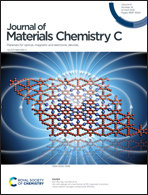Lead-free MnII-based red-emitting hybrid halide (CH6N3)2MnCl4 toward high performance warm WLEDs†
Abstract
Environmentally friendly metal hybrid halides show great promise for white light emitting diode (WLED) applications due to their unique optical properties. Herein, a lead-free blue-light excited red-emitting Mn2+-based hybrid halide (CH6N3)2MnCl4 was obtained via a facile mechanochemical method. (CH6N3)2MnCl4 with octahedrally coordinated Mn2+ ions exhibits intense red emission at 650 nm with a high photoluminescence quantum yield (PLQY) of 55.9% benefiting from its unique crystal structure of ferromagnetic (FM) coupled trimeric [Mn3Cl12]6− linear chains. Besides, (CH6N3)2MnCl4 also possesses excellent thermal stability on account of the relatively weak electron–phonon coupling effect. Moreover, the luminescence intensity of (CH6N3)2MnCl4 can be significantly improved by 8% Zn2+ alloying. The WLEDs with different correlated color temperatures (CCT) fabricated using (CH6N3)2MnCl4:8%Zn2+ and the yellow phosphor Y3Al5O12:Ce3+ (YAG:Ce3+) using a blue LED chip exhibit much better overall electroluminescence performance than those based on (CH6N3)2MnCl4. A warm WLED with a CCT of 3984 K, a high luminous efficacy of 90.41 lm W−1 and a color rendering index (CRI) of 93.7 was obtained based on the modified (CH6N3)2MnCl4:8% Zn2+ halide, indicating its high potential as a red-emitting component for WLED applications.



 Please wait while we load your content...
Please wait while we load your content...